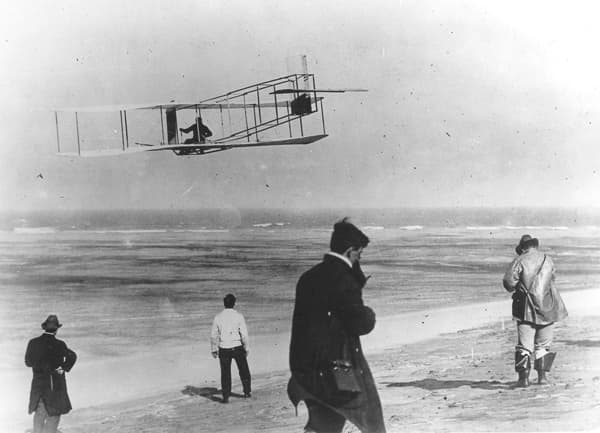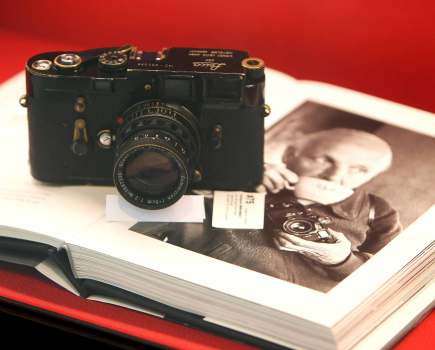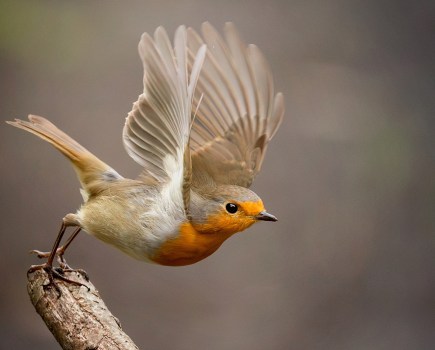Wright brothers’ image: Orville Wright at the controls of the Wright Flyer 1 as his brother Wilbur looks on during the plane’s maiden flight at Kill Devil Hills,
North Carolina, on 17 December 1903 © John T Daniels/AP/Press
Association Images
When Wilbur and Orville Wright asked amateur photographer John T Daniels to photograph an aviation experiment on 17 December 1903, it was not only the first time Daniels had taken a picture, but it was also the first time he had ever seen a camera. On that day, Daniels witnessed the first-ever powered flight and was responsible for photographing one of the most significant events of the 20th century.
At the time, Daniels was a 30-year-old member of the crew at the life-saving station on the coast at Kill Devil Hills, North Carolina in the USA. He and other crew members had got to know Orville Wright and his older brother Wilbur during the time they were preparing for their flight, and they often helped the brothers set up their experimental aircraft.
‘I never saw men so wrapped up in their work in my life, “Daniels recalled in a 1927 interview with Collier’s Weekly. ‘We had watched them for several years and seen how they figured everything out before they attempted it… we knew that they were going to fly, but we didn’t know what was going to happen when they did.”
The technically minded Wright brothers had developed their mechanical skills in earlier business ventures, such as printing presses, and bicycle and motor design. They formed an interest in the possibility of flight in the late 1890s, and began designing and building gliders in 1900.
The brothers were also accomplished amateur photographers. They taught themselves to develop and print their own photographs in a small shed in the back yard of their home in Dayton, Ohio. As well as using photography to document and record their work, they also photographed many other subjects. Most of their surviving negatives are portraits of people, including their family and friends.
They used a Korona Series V camera made by the Gundlach Optical Company, which they bought for $85 in 1898. It was one of the most expensive cameras of the time and used 7×5-inch glass-plate negatives.
In 1903, Orville and Wilbur were ready to attempt their first powered flight. The design for their new aircraft, the Wright Flyer I, incorporated propellers and a petrol engine they had designed and built especially for the aircraft. On 17 December, after several weeks of delays caused by broken propeller shafts, the brothers were ready to attempt their landmark flight. They chose Kill Devil Hills, near Kitty Hawk, as the location for its strong coastal winds and its featureless landscape that was devoid of obstacles.

Image: The Wright brothers went on to develop more sophisticated and successful aircraft © AP/Press Association Images
Conditions were perfect on the day. Orville set up the camera on a tripod and pointed it towards the end of the Flyer’s launch rails, where it was expected to lift into the air. It was vital to photograph the flight – partly as a historical record and partly to prove that it had occurred in the event of other rival designers’ patent claims.
As Orville was due to pilot the aircraft while lying on the lower wing and Wilbur would be helping him launch it, John T Daniels was entrusted with squeezing the bulb that would fire the shutter.
At 10.35am, watched and cheered on by Daniels and four other onlookers, Orville climbed aboard the plane and started the engine. It set off along the launch track and Wilbur ran beside it, steadying the right wing before take-off.
The aircraft lifted into the air and travelled 120ft (36.5m) in a flight approximately 10ft (3m) above the ground that lasted 12 seconds. Daniels took the iconic photograph shortly after the plane left the ground, with Wilbur the solitary figure on the right of the frame. Daniels later admitted he was so amazed and excited by seeing the plane take off that he almost forgot to fire the shutter.
Three more flights followed that day, each covering a greater distance, until the final flight of more than 850ft (260m) ended with the aircraft pitching into the ground. After the Wright brothers and the life-saving crew carried the Flyer back, it was caught by the wind and flipped over several times. Daniels tried to hold on to it, but was caught up in the disintegrating machine. He wasn’t badly injured, but the Flyer was severely damaged and never flew again.
 Image: Portrait of photographer John T Daniels taken in 1945 © Gabriel Benzur/Time & Life Pictures/Getty Images
Image: Portrait of photographer John T Daniels taken in 1945 © Gabriel Benzur/Time & Life Pictures/Getty Images
After that historic day, the brothers went on to develop aircraft of greater complexity and reliability, to be recognised for their achievement with an award from President Taft and regarded as the founding fathers of modern aviation. Wilbur died in 1912, aged 45, but Orville lived until 1948 – long enough to see his invention result in the first supersonic flight in 1947.
Meanwhile, John Daniels continued working for the Kill Devil Hills Life Saving Station until his retirement. In later years he would show visitors a piece of the Flyer that the brothers gave him. He died in 1948, the day after Orville Wright’s death. His only known act as a photographer is commemorated in a bronze sculpture of himself on the sands where he recorded the birth of the aviation age.
Wright brothers Books and websites
Books: Books on the Wright brothers include The Wright Brothers: How They Invented the Airplane by Russell Freedman. For more detail on the pictures see Hidden Images: Discovering Details in the Wright Brothers’ Kitty Hawk Photographs 1900-1911 by Larry E Tise (selections available on https://books.google.com).
Websites: For a good general introduction to the Wright brothers, see www.wikipedia.org. More details on their first flights are available on www.nasm.si.edu/wrightbrothers (click ‘Online Exhibition’).
Other key events of early 1900s
- 1900: The Galveston Hurricane sweeps through Texas with winds of up to 135mph, causing the deaths of around 8,000 people. It remains the USA’s worst-ever natural disaster
- 1900: George Eastman’s company Kodak launches the first Box Brownie. It’s a basic box camera which records 2¼in square pictures on rollfilm. Its low price ($1) and simple controls brings photography to a wider audience
- 1901: Queen Victoria dies aged 81 after reigning for 63 years – longer than any other British monarch. She is succeeded by her son, Prince Albert Edward, who is crowned King Edward VII the following year
- 1902: The Second Boer War, fought between Britain and Afrikaans-speaking Boers in South Africa, comes to an end after tens of thousands of deaths on both sides
- 1906: San Francisco, California, is struck by a major earthquake. The damage to the city caused by the earthquake and the resulting fire results in a death toll of more than 3,000 people
- 1908: The first Ford Model T car is produced by the Ford Motor Company in Detroit, Michigan. It’s the first car to be mass produced on assembly lines and 15 million are sold by the time production ends in 1927
- 1908: London hosts the fourth Summer Olympic Games of the modern era
- 1909: French aviator Louis Bleriot becomes the first man to fly across the English Channel in a heavier-than-air craft. He receives a prize of £1,000 for his achievement







